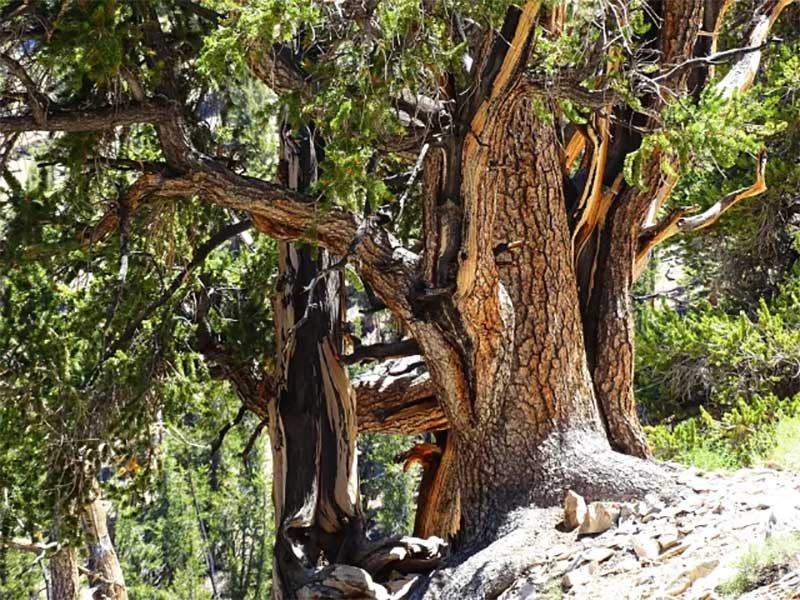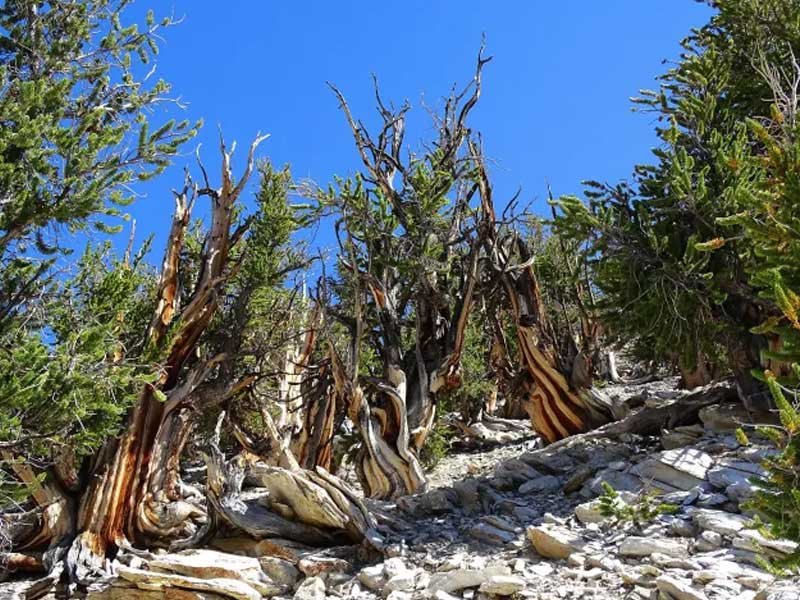The oldest known tree in the basin, Methuselah
Trees are among the oldest living organisms on Earth. They silently witness centuries of human history, natural changes, and the passage of time. Among them, the oldest known living tree in the world is called Methuselah, a bristlecone pine that stands in the White Mountains of California, USA.
This ancient specimen, a Great Basin Bristlecone Pine (Pinus longaeva), has stood silently in the harsh, high-altitude environment of eastern California for millennia, witnessing nearly 5,000 years of human history.
Methuselah (Pinus longaeva), a Great Basin bristlecone pine, has been scientifically dated to be around 4,856 years old. It germinated long before the construction of the Egyptian pyramids, the founding of Rome, or even the invention of writing in many ancient civilizations.
The tree was discovered and dated in the 1950s by dendrochronologist Edmund Schulman, whose work revealed just how incredibly long-lived bristlecone pines could be.
Methuselah is located in Inyo National Forest in eastern California. However, its exact location is kept secret to protect it from vandalism and damage caused by excessive tourism. Visitors can explore bristlecone pine groves in the area, but they won’t know which tree Methuselah is.
Similar to Hyperion, the U.S. Forest Service keeps the exact location of Methuselah a strict secret. The primary reason for this secrecy stems from a tragic event involving another famous bristlecone pine named Prometheus. In 1964, a graduate student, with permission from the Forest Service, cut down the 4,900-year-old Prometheus for research purposes, not realizing until after the fact that it was the oldest known tree at the time. To prevent any similar accidents or intentional vandalism, Methuselah’s identity and location are now rigorously protected.
The Bristlecone Pine’s immense age is a testament to its adaptation to an extremely challenging environment. Rather than thriving in a lush, nurturing setting like the coastal redwoods, it survives in conditions that would kill most other trees:
Bristlecone pines are uniquely adapted to survive in harsh environments:
This resilience makes bristlecone pines some of the most durable and oldest living organisms on Earth.

The oldest known tree in the basin is 5,065 years old and was germinated in 3051 BC. This tree started growing before the first pyramid was built-in Egypt.
While Methuselah is celebrated as the oldest non-clonal individual tree, the title of the world’s oldest living organism belongs to a massive grove of Quaking Aspen named Pando. Located in Utah, Pando is a vast colony of genetically identical trees connected by a single, immense root system. Pando is estimated to be around 14,000 years old, though no single stem lives longer than a century.

Another, Methuselah, is 4,848 years old.
While Methuselah is currently recognized as the oldest known individual living tree, there are other contenders:
Methuselah, however, remains the oldest known non-clonal living tree still standing.
The story of Methuselah, the oldest tree in the world, is a symbol of longevity, survival, and natural history. Its existence reminds humanity of the importance of preserving our environment, protecting fragile ecosystems, and respecting the incredible life forms that have stood the test of time.
Q: What is Methuselah?
A: A bristlecone pine tree in California, nearly 4,850 years old.
Q: Where is Methuselah found?
A: In the White Mountains, California, USA.
Q: Why is Methuselah famous?
A: It is one of the oldest known non-clonal trees on Earth.
Q: What tree once rivaled Methuselah’s age?
A: The Prometheus tree, cut down in 1964, was about 4,900 years old.
Q: Where was Prometheus located?
A: Wheeler Peak, Nevada, USA.
Q: What is Old Tjikko?
A: A clonal spruce tree in Sweden, about 9,560 years old.
Q: Why is Old Tjikko older than Methuselah?
A: Because it regenerates clonally from its root system.
Q: What is the oldest clonal tree colony?
A: Pando, a quaking aspen colony in Utah, USA, over 80,000 years old.
Q: How does Pando survive so long?
A: Its root system continuously sprouts new trees.
Q: What is Sarv-e Abarqu?
A: A cypress tree in Iran, estimated around 4,000 years old.
Q: What is Jomon Sugi?
A: An ancient cedar tree on Yakushima Island, Japan.
Q: How old is Jomon Sugi?
A: Between 2,000 and 7,000 years.
Q: Which is the oldest tree in Europe?
A: Italus, a Heldreich’s pine in Italy, about 1,230 years old.
Q: What is the oldest olive tree?
A: The Olive tree of Vouves in Crete, Greece, over 2,000 years old.
Q: What is Alerce Milenario?
A: A Patagonian cypress in Chile, possibly more than 5,000 years old.
Q: Why is the Alerce Milenario important?
A: It may be older than Methuselah, but not fully confirmed.
Q: Which tree is called the “Tree of Life” in Bahrain?
A: A 400-year-old Prosopis tree growing in the desert.
Q: What is Gran Abuelo?
A: A Patagonian cypress in Chile, estimated around 3,600 years old.
Q: Why are bristlecone pines so long-lived?
A: Their dense wood and harsh climate slow decay.
Q: What do scientists learn from old trees?
A: Climate history and environmental changes over thousands of years.
Q: How do scientists determine a tree’s age?
A: By counting tree rings (dendrochronology) or using radiocarbon dating.
Q: Why is Methuselah’s exact location secret?
A: To protect it from vandalism and tourism damage.
Q: Are there other ancient trees in the Himalayas?
A: Yes, deodar cedars and junipers several thousand years old.
Q: Which ancient tree is sacred in Buddhism?
A: The Jaya Sri Maha Bodhi tree in Sri Lanka, over 2,300 years old.
Q: Why should humanity protect ancient trees?
A: They are living history, biodiversity hotspots, and vital for ecosystems.
Q: What species of tree is Methuselah?
A: The Great Basin Bristlecone Pine (Pinus longaeva).
Q: What is Methuselah’s estimated age?
A: Approximately 4,856 years old (as determined in 1957).
Q: In which mountain range and US state does Methuselah reside?
A: The White Mountains of eastern California.
Q: Methuselah’s age makes it older than which famous ancient structure?
A: The Egyptian pyramids.
Q: Why is the exact location of Methuselah kept a strict secret?
A: To prevent vandalism or accidental cutting.
Q: Which US agency is responsible for protecting its location?
A: The U.S. Forest Service.
Q: What is the name of the 4,900-year-old bristlecone pine that was tragically cut down in 1964?
A: Prometheus.
Q: What scientific field determined the age of Methuselah?
A: Dendrochronology (the study of tree rings).
Q: What elevation do these ancient Bristlecone Pines typically grow at?
A: Between 9,800 and 11,000 feet.
Q: What is the growth rate of Bristlecone Pines due to the cold, harsh climate?
A: They grow extremely slowly.
Q: What quality of the wood makes it highly resistant to insects and fungi?
A: It is very dense and full of resin.
Q: What are the key characteristics of the soil they grow in?
A: Rocky, nutrient-poor, and dry.
Q: What unique survival mechanism allows them to endure harsh conditions?
A: Segmented Survival.
Q: In segmented survival, what is the thin strip of living tissue connecting the roots to the branches called?
A: The cambium.
Q: How does segmented survival help the tree conserve resources?
A: By shutting down sections that are too harsh to support life.
Q: What condition is freezing for much of the year in their habitat?
A: Temperatures (due to the high elevation).
Q: What is the name of the massive grove considered the world’s oldest living organism?
A: Pando.
Q: What species of tree makes up the Pando organism?
A: Quaking Aspen.
Q: In which US state is the Pando organism located?
A: Utah.
Q: What is Pando’s estimated age?
A: Around 14,000 years old.
Q: What is the key difference between Methuselah and Pando?
A: Methuselah is a non-clonal individual, while Pando is a clonal organism.
Q: What connects all the genetically identical trees in the Pando colony?
A: A single, immense root system.
Q: How long does a single stem (trunk) in the Pando grove typically live?
A: No longer than a century.
Q: Methuselah predates the existence of which historical empire by several thousand years?
A: The Roman Empire.